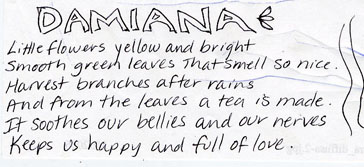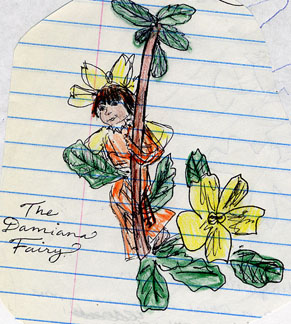Damiana is a small perennial shrub that is native to Mexico, Central America, and Texas. The plant has small yellow flowers and green leaves, all parts being aromatic. The leaves are usually made into a tea. Damiana tea has been used for centuries as a tonic for the genito-urinary system. It is also used for the nervous, hormonal, and digestive systems. Damiana is commonly sold in Mexico in the form of a liqueur. Damiana seems to be most well-known for its aphrodisiac properties.
--------------------------------------------------------------------------------------------------------------------------------------------------------------
Damiana
Family Name: Turnera
Latin Family Name: Turneraceae
Latin Name: Turnera diffusa or Turnera aphrodisiaca
Common Names: Damiana, Mexican damiana, old woman’s broom, herba de la pastora, hierba del venado, oreganello, el borrique, Mexican holly, damiana de Guerrero.
Related Species: Turnera opifera (5), T. ulmifolia (5,10), T. microphylla(10).
Body System Affiliations:
- Nervous system
- Urinary system
- Reproductive system
- Hormonal system
- Digestive system
Botanical Description:
Habit: Small perennial shrub.
Size: Grows to about 24 inches/60 centimeters in height.
Arrangement: Alternate or in bunches.
Leaves: Pale green and smooth on top, glabrous with a few hairs on ribs underneath. Ovolanceolate- one half to one inch/15 to 25 millimeters long and quite narrow. Serrated edges. Shortly petiolate with two small glands at base. Widely spaced. Strong resinous aroma when crushed (1,13).
Flowers: Small, bright yellow, rising from the leaf axils(6). Looks like small hibiscus (2:119). Aromatic; sometimes compared to chamomile. Taste is bitter, characteristic, aromatic and resinous.
Fruit: Capsule. One-celled splitting into three pieces(6). Many-seeded, globular fruit with resinous coating (12). Sweet smell, fig-like flavor (10).
Ecology:
Habitat: Hot humid climates (12). Dry, sunny, rocky hillsides (1). Sandy places(13).
Range: Mexico, South Texas(1), Southern California(1), Central America(1), South America(5), West Indies(5), parts of subtropical America and Africa (5).
Native Where: Mexico(6,12), Central America(12), Texas, Southwest United States (6).
Western (European-American) Uses/Relationships:
Food: Used in Mexico to flavor liqueurs, teas, and other beverages and foods (1).
Materials/Technology: None found.
Medicine:
Part used: Leaves and sometimes stems
Medicinal Actions: Stimulating nerve tonic (3:326,4:211,8), anti-depressant (3:326,4:211,8), diuretic(1,5), urinary antiseptic(4:211,8), mild purgative (1,4:211,8,10), aphrodisiac(3,4:211,7,8,12), euphoric (7), hallucinogenic (1).
Indications: Anxiety and/or depression (especially with predominant sexual factor) (3,4:212,8), digestion(4:212,7), nephritis(8,11), impotence(3:326,4:212), ‘frigidity’(8), menstrual headaches(1,3,4,8), menopause disorders(1,9), dysmenorrhea(1,8), infertility(3:326,10), muscle and nerve exhaustion(3:326), dream therapy(3:326), asthma(1,2,12), bronchitis(12), bedwetting (10,11).
Body System Associations:
- Nervous system (3:326,4:211,8)
- Urinary system (1,3:326,4:211)
- Reproductive system (4:211,7)
- Hormonal system (1,4:211,8)
- Digestive system (1,4:211)
Constituents: Volatile oil (1,4:211,5,6,8,10,11), arbutin (8,10,11), damianin (5,8,11,13), resins (8,12), tannins (5,7,8,10,12).
Applications: Infusion, tincture, capsules(1,3:326), brownies(7), mead(7), liqueur, smoking(2:119).
Preparations:
Infusion: 1 teaspoon(2:119,8)/2 tablespoons(7)/half a cup(1) of dried leaves to 1 cup water for 15 minutes.
Tincture: 1 ounce dried leaves in 1 pint vodka for 5 days (7).
Brownies: Add dried leaves to brownie recipe at same levels as for marijuana (7).
Mead: 1 ounce per gallon at the beginning of the fermentation process in a standard recipe (7).
Liqueur: Sold in Mexico as Crème de Damiana (4:212).
Pharmacy:
Infusion: 1 cup 2-3 times a day (1,4:212,6,7).
Tincture: 1-3 ml 2-3 times a day (1,8).
Capsules: 3-8 grams 2 times a day (1).
Other: “Useful in magical work in that it aids in the breaking down of the natural mental barriers and inhibitors…”(7).
Cautions: Large doses may cause loose stools (1,12). Excessive long term use may be toxic to liver, similar to alcohol (1,7). May interfere with iron absorption (10,12). Not to be used while pregnant or breastfeeding (10,12).
Indigenous and Non-Western Use/Significance/Relationships:
Food: None found.
Materials/Technology: None found.
Medicine:
Indigenous Groups: Native people of Mexico (1,8,9,10). Mayans (1,10).
Part Used: Leaves.
Medicinal Actions: Aphrodisiac(1,8,9,10,12), stimulant tonic(1,8), hallucinogenic (1), emmenagogue (8).
Indications: To boost sexual potency in men (1), diabetes (10).
Energetics: Warming, bitter, pungent (13).
Harvest: Not found.
Storage: Not found.
Preparation: ‘A drink from damiana leaves, added sugar’ (10).
Applications: Infusion (1,9).
Pharmacy: For hot flashes: half a cup of tepid tea before bed and same in the morning (9). As aphrodisiac: drink infusion half an hour before ‘beginning your
romance’(2:119).
Cautions: None found regarding indigenous uses.
Other:
Propagation:
Technique: Seeds and cuttings(6,13), division(13).
Timing:
Seed: Sow spring in greenhouse. Put seedlings in individual pots once large enough to handle. Keep in greenhouse through at least one winter. Plant in permanent positions in early summer and give some protection from winter cold for at least their first winter outdoors(13).
Division: in spring or autumn(13).
Cuttings: of half-ripe wood, July/August in a frame. Overwinter the young plants in a greenhouse and plant them out in early summer(13).
Harvest:
Plant Part: Leaves and tops.
Season of Harvest: After rains [Baja Cape region- Sept/Oct, Jan/Feb] (9). When in flower (1,6,8,10,12). Early to late summer (10). Before flowering (2:119).
Method of Harvest: Gather branches, dry in shade, then strip leaves (6,9).
Ecological Considerations of Harvest: No more than a few branches from each plant (9).
Cultural Considerations of Harvest: The liqueur industry in Mexico uses vast quantities of the leaf, which is hand gathered by individuals who sell it (9). Could be competitive and/or dangerous to gather from certain areas.
Cautions: None found regarding harvest.
Personal Experience:
Medicine:
Part Used: Leaf
Desired Medicinal Actions: Nerve tonic, aphrodisiac.
Targeted Indications: Mild anxiety, low libido.
Procurement:
Source: Radiance Herbs & Massage
Condition: Dried
Cost: $1.50 for one ounce
Other Procurement Information: Grown in Mexico and South America.
Application/Preparation/Pharmacy:
Applications: Liqueur
Preparation: Damiana Chocolate Love Liqueur (3:245)
1 ounce damiana leaves
2 cups vodka or brandy
1 ½ cups spring-water
1 cup honey
Vanilla extract
Rosewater
Chocolate syrup
Almond extract
- Soak the damiana leaves in the vodka or brandy for 5 days. Strain; reserve the liquid in a bottle.
- Soak the alcohol-drenched leaves in the spring-water for 3 days. Strain and reserve the liquid.
- Over low heat, gently warm the water extract and dissolve the honey in it. Remove the pan from heat, then add the alcohol extract and stir well. Pour into a clean bottle and add a dash of vanilla and a touch of rosewater for flavor. Let it mellow for 1 month or longer; it gets smoother with age.
- To each cup of damiana liqueur, add ½ cup of almond extract, and a touch more of rosewater.
Pharmacy: 1-2 ounces of liqueur.
Reason/Purpose: To revive the fun and lovin’ in the relationship with my lover.
Experience: Nice.
Cautions based on experience: Make sure all people involved drink it, not just one person.
Other: None.
Other Notes of Interest: Margaritas were originally made with damiana liqueur, not triple sec and tequila (2:118). Damiana has traditional use as an abortive (10).
Cautions: Large doses may cause loose stools (1,12). Excessive long term use may be toxic to liver, similar to alcohol (1,7). May interfere with iron absorption (10,12). Not to be used while pregnant or breastfeeding (10,12).
References Cited:
1. Davidson, Tish. Gale Encyclopedia of Alternative Medicine. Gale Group, 2001. Online at http://www.findarticles.com/p/articles/mi_g2603/is_0000/ai_2603000043. Visited 2/8/06.
2. de la Tour, Shatoiya. Earth Mother Herbal: Remedies, Recipes, Lotions, and Potions from Mother Nature’s Healing Plants. Massachusetts: Fair Winds Press, 2002.
3. Gladstar, Rosemary. Rosemary Gladstar’s Family Herbal: A Guide to Living Life With Energy, Health, and Vitality. North Adams, Massachusetts: Storey Books, 2001.
4. Green, James. The Male Herbal: Health Care for Men and Boys. Freedom, California: The Crossing Press, 1991.
5. Grieve, Mrs. M. A Modern Herbal. 03 June 2004. Online at http://botanical.com/botanical/mgmh/d/damian05.html. Visited 2/8/06.
6. Grubber, Hudson. Growing the Hallucinogens. 1997. Online at http://nepenthes.lycaeum.org/Plants/growing.html#DAMIANA. Visited 2/14/06.
7. Herron, Lori. Alternative Nature Online Herbal. 1998. Online at http://altnature.com/library/damiana.html. Visited 2/8/06.
8. Hoffman, David L. Health World Online. Online at http://www.healthy.net/scr/article.asp?ID=1873. Visited 2/8/06.
9. Moore, Lee. Excerpt from The Baja Kitchen. Todos Santos Press. Online at http://www.todossantos.cc/monthly.html. Visited 2/8/06.
10. Taylor, Leslie. Raintree Nutrition. “The Healing Power of Rainforest Herbs.” 2005. Online at http://www.rain-tree.com/damiana.htm. Visited 2/14/06.
11. Author Unknown. Alpha Omega Labs. 26 August 2004. Online at http://www.altcancer.com/phyto.damiana.htm. Visited 2/14/06.
12. Author Unknown. Dynamic Chiropractic. 01 February 2004. Online at http://www.chiroweb.com/tyh/damiana.html. Visited 2/14/06.
13. Author Unknown. Plants for a Future Database. 2000. Online at http://www.ibiblio.org/pfaf/cgi-bin/arr_html?Turnera+diffusa+aphrodisiaca&CAN=LATIND. Visited 2/18/06.
Arts, Environment and the Child: Walking the Wheel of the Seasons
**********************************************************************

